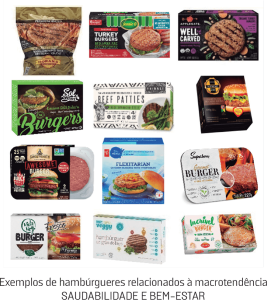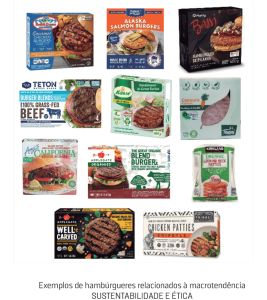CONSUMPTION TRENDS FOR INDUSTRIALIZED HAMBURGERS
The existing records about the origin of hamburgers allow us to suppose that the fact they are a nutritional, tasty options, with low cost and the of practical preparation, its incorporation was determining to the dietary habits of many countries, whether to be consumed at snack bars or for homemade meals. In addition to these attributes, currently hamburgers have been through a transformation moment regarding the benefits realized by consumers.
The study Brasil Food Trends 2020 serves as base to understand this transformation process in industrialized hamburgers characteristics, from the analysis in the Brazilian and global markets, of different products, at the light of the Convenience and Practicality, Sensory and Pleasure, Health and Well-being, Reliability and Quality and Sustainability and Ethics.
CONVENIENCE and PRACTICALITY
 Easy to prepare food, Ready and Semi-ready dishes, Products for microwave ovens, etc.
Easy to prepare food, Ready and Semi-ready dishes, Products for microwave ovens, etc.
In 2010, the Convenience and Practicality macrotrend was highlighted as the most present in Brazilian population. A recent study about the meat consumption has demonstrated that consumers are valuing more the convenience, causing the growth in the demand for products that eliminate one or more of the preparation stages, ready for consumption and, in a higher volume, the meals preparation kits with all the ingredients required to the respective recipe.
It was observed that young people between the ages of 18 and 24 are the consumers who spend the least amount of time preparing their meals, indicating that convenience for this audience tends to be increasingly important. Similarly, a research report by the Food Marketing Institute (FMI) and the North American Meat Institute (NAMI) observed a marked growth in sales of meat products with a focus on convenience.
Focused on practicality, the hamburger market comprises frozen products that go straight from the freezer to preparation in a frying pan or oven. Ready products, heated in the microwave oven, are even faster meal alternatives. Recently, the hamburgers preparation kits, including bread and side orders, allow the consumer himself to prepare more elaborated recipes, saving time and effort. In the FMI/NAMI research, the purchase of kits to prepare meals was observed in 40% of the respondents.
SENSORY and PLEASURE
 Strong sensory appeal, Premium, Variety of flavors, Appeal to Comfort Food, Gourmet, Exotic, Socialization, Cooking and gastronomy, etc.
Strong sensory appeal, Premium, Variety of flavors, Appeal to Comfort Food, Gourmet, Exotic, Socialization, Cooking and gastronomy, etc.
Regarding the Sensory and Pleasure macrotrend, frozen products follow the same trends as the catering services, with the evolution of traditional hamburgers menus into more sophisticated ones, with higher added value, with the industry offering different flavors with better quality ingredients and claims for premium, gourmet, artisanal, 100% m etc.
HEALTH AND WELL-BEING
 Fortified food, Gastrointestinal health, Fat reduction, Functional food, Diet food, natural Ingredients, Plant-based, natural, organic products, etc.
Fortified food, Gastrointestinal health, Fat reduction, Functional food, Diet food, natural Ingredients, Plant-based, natural, organic products, etc.
The Health and Well-being macrotrend has been exercising a strong influence on the meat products consumers, generating an increase in the demand for new products that offer benefits to the health and do not have ingredients or substances that have been associated to non-transmissible chronic diseases.
The FMI/NAMI research verified that two-thirds of the North American consumers seek for healthier option when buying meat products, and that three-fourths of these consumers introduced similar plant-based products in their daily meals.
RELIABILITY and QUALITY
 Traceability, Guarantee of origin, Good Manufacturing Practices (GMP), Quality and safety certificates ans seals, etc.
Traceability, Guarantee of origin, Good Manufacturing Practices (GMP), Quality and safety certificates ans seals, etc.
The Reliability and Quality macrotrend comprises the increasingly concern with toe origin of raw materials and producers, processing industries and retailers transparency, in order to prove the safety of the product for consumption. According to the FMI/NAMI research, more than half of North American consumers want to find products prepared with meat from cattle feed no natural pasture (grass-fed), all natural and free from antibiotics and hormones.
SUSTAINABILITY and ETHICS
 Low environmental impact, Less carbon footprint, Environmental certifications and seals, Animal well-being, Sustainable production (Organic), Recyclable packages, etc.
Low environmental impact, Less carbon footprint, Environmental certifications and seals, Animal well-being, Sustainable production (Organic), Recyclable packages, etc.
The trends related to Sustainability and Ethics re strictly associated to two macrotrends previously mentioned. For example,plant based similar meat products have a strong demand due to its image of healthier and more sustainable food. Notably, the plant-based products market grows significantly among people called as flexitarian, who want to reduce the meat consumption, but without giving up the pleasure of eating the usual foods.




